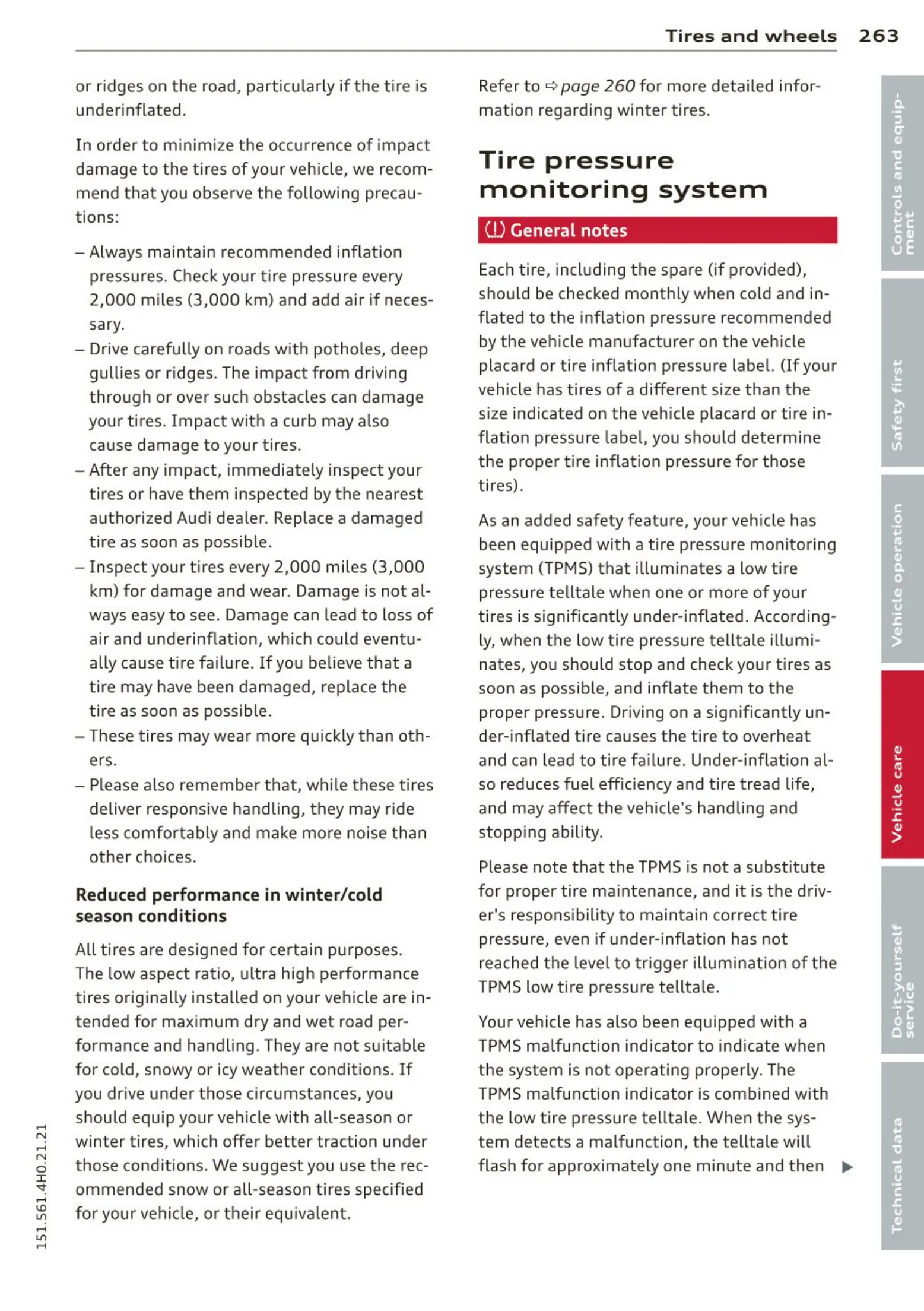,....,
N
,....,
N
0
J:
'SI:
,....,
\!)
1.1'1
,....,
1.1'1
,....,
or ridges on the road, particularly if the tire is
underinflated .
In o rder to minim ize the occu rrence of impact
damage t o the t ires of your veh icle, we recom -
mend that you observe the following precau-
tions:
- Always maintain recommended inflat ion
pressures. Chec k your tire pressure every
2,000 miles (3,000
km) and add air if neces-
sary.
- Drive carefu lly on roads with potholes, deep
gullies or ridges. The impact from driving
through or over such obstacles can damage
your tires. Impact with a curb may a lso
cause damage to your tires.
- After any impact, immediately inspect your
t ires or have them inspected by the nearest
authorized Audi dealer. Replace a damaged
t ire as soon as possible .
- Inspect your t ires every 2,000 miles (3,000
km) for damage and wear. Damage is not al-
ways easy to see. Damage can lead to loss of
air and underinflation, wh ich could eventu-
ally cause tire failure. If you be lieve that a
t ire may have been damaged, replace the
t ire as soon as possible.
- These tires may wea r mo re quickly than ot h-
ers.
- Please a lso remember that, whi le these tires
deliver respons ive handling, they may ride
less comfortably and make mo re noise than
othe r choices.
Reduced performance in winter / cold
season condition s
All ti res are des igned for certa in pu rposes.
The low aspect ratio, ultra high performance
tires originally installed on your veh icle are in-
tended for maximum dry and wet road per-
formance and handling. They are not suitable
for cold, snowy or icy weather condit ions.
If
you dr ive under those circumstances, you
should equip your veh icle with all-season or
winter t ires, which offer better traction under
those cond itions. We suggest you use the rec-
ommended snow or all-season tires specified
for your vehicle, or their equ ivalent.
Tire s an d wheel s 263
Refer to q page 260 for more detailed infor-
mation regard ing winter tires.
Tire pressure
monitoring system
ill General notes
Each tire, including the spare (if provided),
shou ld be checked monthly when cold and in-
flated to the inflation pressure recommended
by the veh icle manufacturer on the veh icle
placard or tire inflation pressure label. (If your
vehicle has tires of a different size than the
size indicated on the vehicle placard or tire in-
flat io n pressure labe l, you shou ld determ ine
t he prope r t ire inflation pressu re fo r those
ti res).
As an added safety feature, your veh icle has
been equipped with a tire pressure mon itoring
system (TPMS) that illum inates a low t ire
pressure te llt ale whe n one or more of you r
tires is significant ly under-inflated . According-
ly, when the low tire pressure te lltale illumi-
nates, you should stop and check your tires as
soon as possib le, and inflate them to the
proper pressure. Driving on a sign ificantly un-
der- inflated tire causes the tire to overheat
and can lead to tire fa ilure. Under-inflation al-
so reduces fuel eff iciency and tire tread life,
and may affect the vehicle 's hand ling and
stopp ing ability.
Please note that the TPMS is not a substitute
for proper tire ma intenance, and it is the driv-
er's respons ibility to maintain correct tire
pressure, even if under-inflation has not
reached t he leve l t o tr igger illuminat ion of the
TPMS low tire pressu re tellta le .
Your vehicle has also been equipped with a
TPMS ma lfu nction ind icator to ind icate when
the sys t em is not operating properly. The
TPMS ma lfunction indicator is combined with
the low tire pressure te lltale. When the sys -
tem detects a malfunction, the telltale will
flash for approximate ly one minute and then ..,.
•
•

